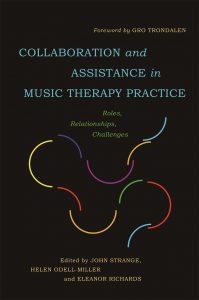A well-trodden territory in need of a map by John Strange
 You can learn about music therapy from books, journals, magazine or newspaper articles, TV or radio programmes, websites or blogs. These sources offer plenty of information, both practical and theoretical, about music therapy clients – their problems, what happens in music therapy and how it helps – and about the music therapist herself – what she does and why. There seems to be much less written and said about various others who may also be in the therapy room, despite the fact that their contribution is often crucial to the effectiveness of the therapy. It was this imbalance in the available information about what actually goes on in music therapy which I and my co-editors Professor Helen Odell-Miller and Eleanor Richards set out to correct in our newly published compilation, Collaboration and Assistance in Music Therapy Practice: Roles, Relationships, Challenges.
You can learn about music therapy from books, journals, magazine or newspaper articles, TV or radio programmes, websites or blogs. These sources offer plenty of information, both practical and theoretical, about music therapy clients – their problems, what happens in music therapy and how it helps – and about the music therapist herself – what she does and why. There seems to be much less written and said about various others who may also be in the therapy room, despite the fact that their contribution is often crucial to the effectiveness of the therapy. It was this imbalance in the available information about what actually goes on in music therapy which I and my co-editors Professor Helen Odell-Miller and Eleanor Richards set out to correct in our newly published compilation, Collaboration and Assistance in Music Therapy Practice: Roles, Relationships, Challenges.
Although many music therapy approaches draw on theories and practices from the field of psychodynamic therapy, it is relatively uncommon to find in music therapy the classic psychoanalytic model of therapist and patient sharing an exclusive private space. The therapy space must be safely contained by therapeutic ‘boundaries’, but the exclusion of others is seldom either practical or desirable. Nurses, care workers, escorts, teaching assistants, family members may for varying reasons need to be present, and their presence creates not only challenges but opportunities which the therapist would be foolish to ignore.
As well as an introduction, concluding chapter and individual chapters by each editor, chapters by invited authors from Thailand, Norway, Cyprus, Ireland and the UK make up more than half the book. Each author illustrates how collaborators and assistants make essential contributions to music therapy for a particular clinical group. Several accounts show how the skills of these ‘others’ in the therapy room develop as they work, rather than by any kind of formal training which, as the final chapter explains, might well be a less effective way of learning the role. The attitude and approach of the music therapist working with the assistance of others is crucial in turning a mere complication into an opportunity to expand the effectiveness and reach of the therapy.
The origin of the book was my doctoral study at Anglia Ruskin University, in which under the expert supervision of the other two editors I investigated music therapy for profoundly learning disabled teenagers with their learning support assistants. My research into the perceptions first of the learning support assistants themselves and then of a panel of music therapists later became Chapters 1 and 13 of the book. Both groups were presented with selected video extracts from the therapy and their reactions were collated with prepared transcriptions of the music. The focus was on developing interactions between individual teenage clients and the familiar staff supporting them by improvising keyboard music from outside the interacting pair, rather than by directly addressing either partner.
Six other chapters also originate in research, including two other recently completed Anglia Ruskin doctoral studies. All the clinical work described was carried out in naturalistic rather than experimental settings, with qualitative research methods featuring more prominently than quantitative. Verbatim comments from participants feature strongly and several chapters offer detailed musical transcriptions of a kind still surprisingly rare in the music therapy literature.
We hope the book will alert therapists and others to the various ways the involvement of collaborators and assistants may enhance therapy or even enable it to take place at all. We also hope that by demonstrating that there is no intrinsic difficulty in writing about such approaches, others will be encouraged to do so.
John Strange chaired the UK Association of Professional Music Therapists from 1995 to 1998, also representing Britain on the European Music Therapy Committee (now Confederation). From 2002 to 2004 he was external assessor of improvisation on the Masters in Music Therapy programme at Aalborg University, Denmark. Since 1995, John has provided expert evidence on music therapy in almost thirty High Court cases of medical negligence. He has contributed chapters to two previous Jessica Kingsley publications and book reviews to the British Journal of Music Therapy. John is also a prolific composer, mainly of church music.